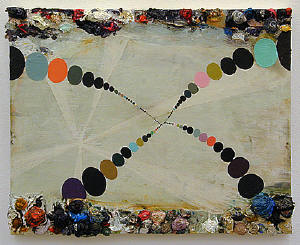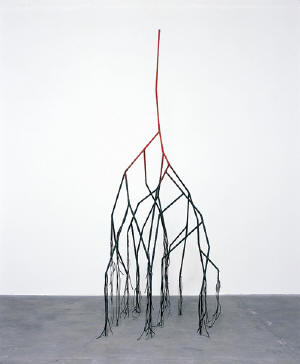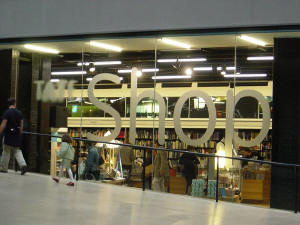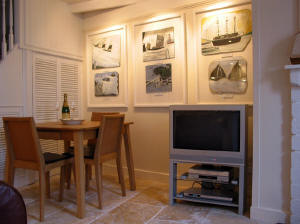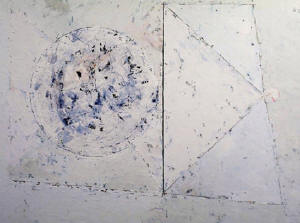|
|
| home | features | exhibitions | interviews | profiles | webprojects | gazetteer | links | archive | forum |
|
Chris Short on debate, ersatz, and the simulation of art Dr
Chris Short is Senior Lecturer in the history and theory
of art at Cardiff School of Art and Design. His published
writings vary from analysis of modern Austrian art to
contemporary British art. Current research includes a
study of the Russian artist, Wassily Kandinsky. He has
recently organised the exhibition: 'St Ives School
1997-2007' starting on January 18th 2007, in Cardiff.
Chris, shall we start by discussing the celebrated St Ives artists of the 40's, 50's and 60's? How do you think they are viewed now and what effect has Tate St Ives had in moulding these perceptions? The most significant thing, I would guess, is that an important but overlooked chapter in British Art has been given a much higher profile. I think the art they produced is becoming increasingly important. In the 80s and early 90s, there was a reaction in the art world against the kind of abstract or near abstract art that many of the important St Ives artists produced. Today, artists and critics are once more interested in the possibility that such art could be recuperated, though not merely repeated, and not merely subjected to a Ďpost-moderní recycling. Good examples were to be seen in this yearís British Art Show 6 exhibition, where modernist formalism appeared in various guises to interesting ends. I think this couples with the excellent job Tate St Ives has done in bringing the publicís attention to historical work done in St Ives to ensure that the work has an important future. Phillip Allen (right), Tomma Abts and the sculptor Eva Rothschild (below left) from the British Art Show - would seem to be 3 good examples. But In my view these younger artists seem to be drawing more from pop-art and op-art: as if they are starting from a different premise, and taking their influences from the generation of international artists that came after St Ives. There are other differences, e.g. a lightness of touch and 'sexiness' in much international contemporary art that makes St Ives artists look a bit over-earnest and drab. When artists do return to modern, more abstract forms of art, whether in the UK or elsewhere, itís rarely as it was developed in St Ives. The truth is that the St Ives artists didnít speak much of the exciting concepts that underpinned so much of modernism, and credit for the development of the kind of painting for which St Ives is known usually leads our attentions elsewhere, particularly to the US. Therefore, the painting done in St Ives is still easily overlooked. It seems to me that painting today covers such a breadth of practice that itís hard to pin-down, but Iíd say there is now a renewed interest in painting as painting, rather than as just another medium for articulation of concepts. This connects back to what I just said about the recuperation of certain forms of modernism. Thereís also an ambition to recover some of the broader social and political Ďcontentí that modern art professed, but now without the totalising world-view of much theorising about modern art. Youíre right - thereís a lightness in this, one that replaces the earnestness of old, but what we see less of today is that vacuous playfulness that became successful in the 80s and 90s.
I argue in the introduction to the catalogue that important art done in and around the town went into decline by the mid-60s. Thatís not to say no important art was done there after that time, just that the momentum of the ĎSt Ives schoolí was lost. Tate St Ives gave the art the chance to Ďworkí once more in the place of its origin, and the art certainly did this. The building showed it to great effect; from the building we could see views of the place to which much of the art referred; and even some of the artists themselves were often to be seen in the galleries. The steam had been put back into the St Ives school, as a historical phenomenon. Unfortunately the impact on art produced in and around the town since has not been all good. Accompanying the Tate has been a great increase in tourism, much of it in search of culture of the sort that the Tate has made popular. There has been a corresponding increase in the number of galleries and art shops in the town, and a huge increase in the amount of stuff produced for sale in them. For the largest part, this has led to a decrease in the quality of art available in the town. It has also resulted in increased prices for rented housing and studio space, effectively pushing-out those very people whose activity is in large part responsible for the success of the place.
I noticed that Alfred Wallis's house in St Ives is available as a themed holiday let (below left). This in particular seems the perfect symbol of this, apparently inexorable, change. Ironic, really. Overall, I think the Tate has been very positive for the art-world of St Ives, but there are many costs attached to the economic success it has facilitated.
Given that many artists In Cornwall continue to make work that is close to the look of modern-ist art from St Ives, the crucial issue for me is whether maintaining a local tradition or vernacular as a gallery owner or artist in St Ives can be recognised as valid and worthwhile. I think it can be, yet I do have sympathy with the following quote from Andy Hughes' book, where you are writing about a lot of the painting in St Ives at the moment: 'In such works, the radical ambitions of St Ives Modernism, which had probably run its course by the early 1960s, are reduced to a completely formulaic enterprise. Thus, the only value attached to the objects is one of exchange, the imagery is reduced to pure surface that simulates art, that generates nothing other than profit. It is what one of modernism's foremost critics, Clement Greenberg, called kitsch, ersatz culture to placate the masses and to ensure that their meagre income is returned to the privileged minority. Can you explain this a bit more? Is it possible to say what the hallmarks of kitsch are in this context, and what it is about e.g. the art-works in the show in Cardiff that makes it different?
The Ďhallmarksí, as you call them, of what Iíve called ersatz culture in St Ives might include an over-use of pretty colours (usually blues and sandy-creams, and syrupy sunset colours) that configure into near-abstract works, and painterly brush marks that in no way disrupt the elegance of the painting. This is not to mention the art that also exploits motifs that relate to the townís rural and fishing identities: dramatic seascapes, views of harbours, bearded fishermen smoking pipes beside lobster pots, and so on, some mass produced and imported from parts of the world where labour is cheap. Weíre talking about a pretty diverse range of products that have developed to exploit all markets and exhaust all pockets. Whatís more, these same hallmarks could be used to different ends: it would be quite possible to use them to make interesting works of art. The work thatís included in the exhibition is diverse. However, I think itís safe to say that all the work seeks to develop the influences upon which it draws, rather than to merely simulate them; the work enters into a critical relationship with art as it exists in the contemporary art world; and the work seeks to address and explore some aspect of contemporary experience in a sustained and important way. Thatís not a very comprehensive statement of the artís worth as art, I know, but perhaps itís a start.
Developing not copying the tradition does seem to be the key - whilst simultaneously being aware of other influences from further afield. As well as Richard Nott and Sax Impey in the Cardiff show, I would say, as examples, that other New Millenium artists like Jeremy Annear (right and below) and Mark Surridge do just this. Yes. The pull of international art is strong for some artists in the county, including many associated with artcornwall yet I think there is still something good and important about a local scene and a local vernacular, if you can call it that. What I think could be enhanced In Cornwall is the debate and the critical discussion around it - because it is this kind of intellectual argument that - in my view - most protects art from charges of being kitsch. How do you see the role of a local art-scene and the debate that takes place there? There are already pockets of exciting art debate in St Ives and Cornwall, and they donít just centre around Tate, Newlyn Art Gallery and Falmouth.
However, there is
a strong Ďrear-guardí, as we might call it. In St Ives, Iíve been struck
over the
years by the resistance there is to the kind of academic and theoretical
debates that feed into and off visual art in other cultural communities.
The resistance arises, I think, from a misplaced and old- The Tate, Newlyn and other institutions in the region must continue to take a lead in developing discourse on art, but it is also up to individuals, smaller groups and independent art galleries to put in the time and effort to develop debate about art in the region. Many do this already, and I think there is plenty of evidence to suggest that artists and writers realise that they will only capitalise on the history and potential of the place if they develop a broader network of discussion and understanding. I also think artcornwall can make a very important contribution to this process. Cornish art mustnít be allowed to slip too easily into the leisure industry that has come to dominate the economy of the county, and it mustnít slip any further into the reach of lazy minds that canít be bothered with the work that contemporary art demands of both the maker and its audience.
The 6 artists in St Ives school 1997-2007 are: Sam Hall, Andy Hughes, Richard Nott, Sax Impey, Graham Gaunt and Andy Whall. See features section.
RW December 2006
Why not respond to this article on the forum???
|
|
|

